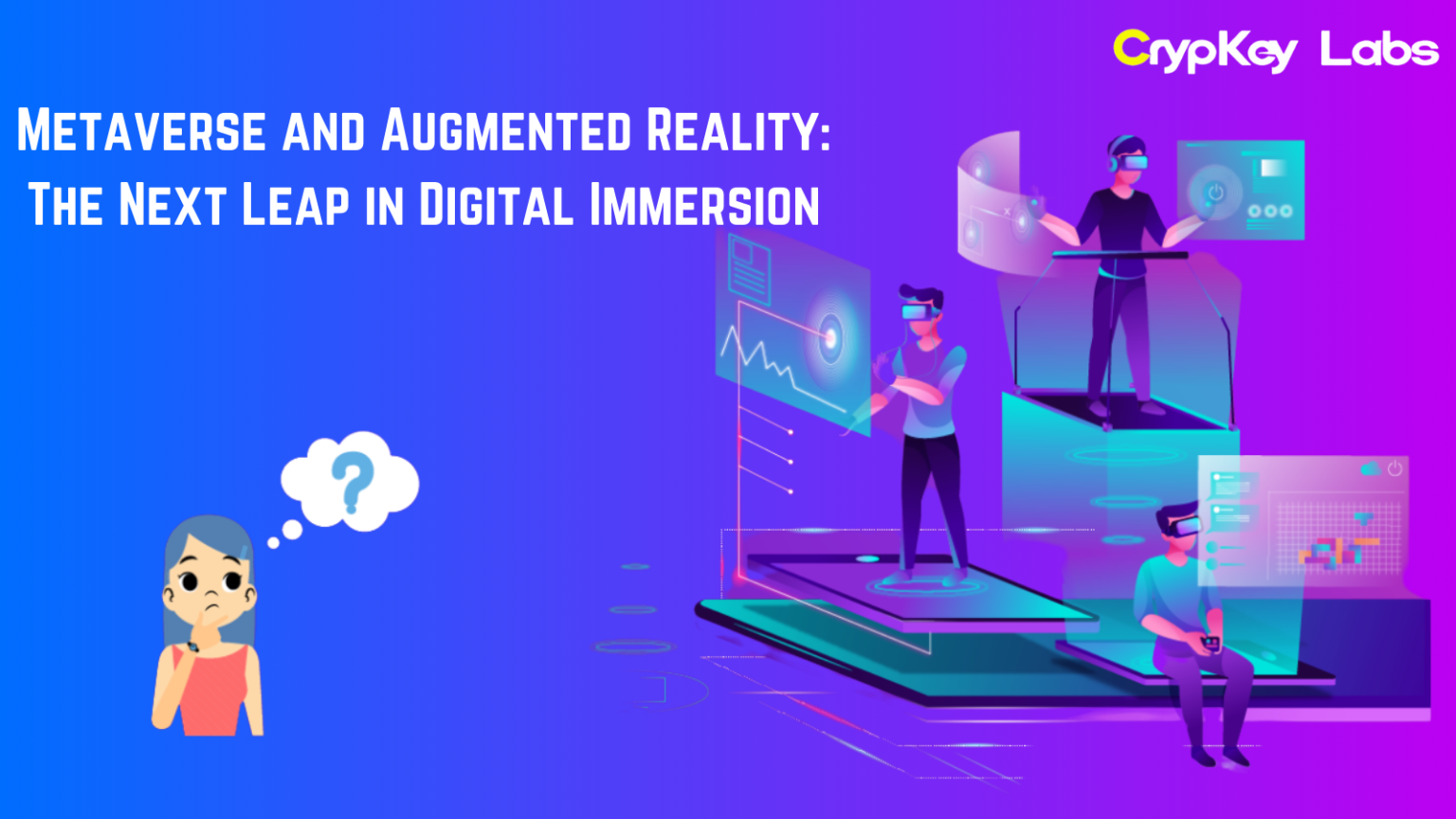The digital world has evolved in so many exciting ways over the past few years. From the advent of social media to the rise of virtual gaming and streaming platforms, we’ve seen a shift toward deeper, more interactive online experiences. But now, we’re standing on the brink of something truly groundbreaking: the Metaverse and Augmented Reality (AR). These technologies promise to take our digital experiences to a whole new level of immersion, offering up new ways to live, work, play, and connect.
In this blog, we’ll dive into what these technologies are, how they work together, and explore the endless possibilities they present for industries, entertainment, and our daily lives. Ready to step into the future? Let’s go!
What is the Metaverse?
You’ve probably heard the term “Metaverse” floating around, but what does it actually mean? In simple terms, the Metaverse is an interconnected virtual universe made up of digital spaces, each offering its own unique experiences. Think of it as a collection of immersive, virtual environments where you can hang out, work, play games, shop, and more. But the beauty of the Metaverse is that it doesn’t just live in one platform or app—it’s decentralized and spans across multiple virtual worlds, all connected together.
Here are a few key components that make up the Metaverse:
- Virtual Worlds: These are digital spaces where users can create avatars and interact with one another, much like a video game. Popular examples include Decentraland and Meta’s Horizon Worlds.
- Avatars: Users can create digital representations of themselves (or go wild and create something entirely unique) that allow them to navigate the virtual world.
- Blockchain Technology: The Metaverse heavily relies on blockchain to ensure ownership and security, particularly when it comes to digital assets like NFTs (Non-Fungible Tokens).
- Augmented Reality (AR) and Virtual Reality (VR): These technologies play a significant role in creating immersive experiences in the Metaverse, offering new ways for users to interact with the world.
In short, the Metaverse is a whole new way to experience the internet—one where we can escape into digital environments and feel truly connected. Pretty cool, right?
Understanding Augmented Reality (AR)
Now, let’s talk about Augmented Reality (AR). While VR (Virtual Reality) puts you entirely in a digital world, AR layers digital elements over your physical world, enhancing your experience with virtual objects or information. You’ve probably experienced AR already if you’ve ever used a Snapchat filter or played Pokémon Go. In these apps, digital images or animations are superimposed onto real-world environments through your phone’s camera.
Here’s a quick rundown of AR’s key features:
- Real World Interaction: AR enhances your real-world surroundings by adding virtual objects or information that interact with the physical environment.
- Immersive Experience: AR can make everyday activities more engaging by adding virtual elements like directions, educational content, or even entertainment in real time.
- Different from VR: While VR immerses you fully into a virtual space, AR integrates digital content into the real world around you.
Examples of AR in action include Ikea’s AR app, where you can place virtual furniture in your home before purchasing, or Google Lens, which uses AR to translate foreign text in real-time through your phone’s camera.
How the Metaverse and AR are Interconnected
So, how do the Metaverse and AR fit together? Well, AR is one of the key technologies that brings the Metaverse to life in the physical world. Think of it as the bridge that allows us to interact with the digital universe without leaving our surroundings.
Here’s how AR enhances the Metaverse:
- Interactive Avatars: Imagine using AR glasses to view your avatar in the real world or interacting with digital objects in your home that belong to the Metaverse.
- Virtual Overlay: AR could allow you to view virtual worlds, art galleries, or other digital content projected onto your physical environment. This could be a game-changer for things like virtual shopping or socializing in the Metaverse.
- Immersive Navigation: AR can guide users in Metaverse spaces through virtual markers or information, allowing them to navigate virtual environments more naturally.
In essence, AR provides a more seamless experience, allowing the virtual world of the Metaverse to blend into the real world. It’s the next step in creating a fully immersive digital experience where reality and the virtual collide.
The Potential of Metaverse and AR in Various Industries
The possibilities for the Metaverse and AR are vast, and almost every industry is already looking for ways to integrate these technologies. Let’s explore a few key areas where these technologies are making an impact:
Entertainment
The Metaverse and AR are already revolutionizing entertainment. In the gaming industry, the line between real and virtual is blurring as gamers can not only experience new worlds but also interact with them in real-time.
- Virtual Concerts: AR can enhance live concerts by superimposing virtual elements like holograms or interactive visuals, creating a one-of-a-kind show.
- Gaming: From immersive AR games like Pokémon Go to full-fledged Metaverse gaming experiences, AR and the Metaverse are transforming how we play and engage with digital entertainment.
Retail and E-commerce
We’ve all done our fair share of online shopping, but imagine being able to try before you buy using AR. Whether it’s seeing how a couch looks in your living room or trying on clothes virtually, the Metaverse and AR can totally change how we shop.
- AR Shopping: With AR apps, you can see how a product will look in your space, giving you more confidence before making a purchase.
- Virtual Stores: In the Metaverse, brands could create entire digital stores where customers can shop for virtual or physical goods, making the retail experience much more interactive.
Education
The education sector stands to benefit enormously from the Metaverse and AR. Imagine attending a virtual lecture where you’re able to interact with 3D models, walk through historical events, or even conduct experiments in a fully immersive, virtual lab.
- Virtual Classrooms: Students can attend classes in virtual spaces, making learning more interactive and engaging.
- Hands-On Learning: AR can provide real-time overlays of helpful information, guiding students through complex subjects like anatomy or physics with interactive elements.
Healthcare
In healthcare, both the Metaverse and AR are already starting to make their mark. Surgeons can practice complex procedures in virtual environments, while AR can assist them during actual surgeries by projecting crucial information onto their view.
- AR-assisted Surgeries: Surgeons can use AR to view patient data and imagery during operations, improving accuracy and outcomes.
- Virtual Therapy: Metaverse platforms could be used for mental health therapy, offering virtual counseling sessions or support groups in immersive settings.
Real Estate
The real estate industry is also leveraging AR and the Metaverse to offer more interactive property tours. Instead of just viewing a listing online, potential buyers can take virtual tours of properties and visualize renovations with the help of AR.
- Virtual Property Tours: Using VR and AR, homebuyers can view properties from the comfort of their own homes, experiencing a fully immersive walkthrough before making a decision.
- Design and Customization: In the Metaverse, clients can design or customize virtual homes before making real-world decisions, blending the virtual with reality.
Challenges and Barriers to Adoption
Of course, as with any new technology, there are challenges to widespread adoption of the Metaverse and AR. Let’s take a look at a few roadblocks:
- Hardware Limitations: Devices like AR glasses and VR headsets still have limitations in terms of cost, comfort, and accessibility. Until these become more affordable and user-friendly, mainstream adoption might take time.
- Privacy and Security: As we spend more time in virtual spaces, privacy concerns will grow. How do we ensure our personal data is safe in the Metaverse? What’s the risk of cyber-attacks or data breaches in virtual environments?
- Ethical Considerations: With the growth of virtual worlds comes the potential for addiction, identity issues, and social isolation. Balancing immersion with real-world experiences will be crucial to ensuring these technologies are used responsibly.
The Future of Metaverse and AR
Looking ahead, the future of the Metaverse and AR is incredibly exciting. As the technology continues to evolve, we can expect even more immersive experiences that will shape how we live and interact with the world. Here are a few predictions:
- Smarter Devices: Future AR glasses, headsets, and even contact lenses could be more comfortable and less intrusive, seamlessly blending digital elements into our daily lives.
- Virtual Economy: With the integration of blockchain and NFTs, the Metaverse will likely see a boom in virtual goods, currencies, and marketplaces.
- Integration with AI: The Metaverse and AR could evolve even further with the integration of AI, allowing for smarter, more dynamic experiences.
Conclusion
The Metaverse and Augmented Reality are ushering in a new era of digital immersion. As these technologies evolve, they’ll offer us endless possibilities for entertainment, education, work, and socialization. Whether you’re gaming, shopping, or learning, the Metaverse and AR are poised to redefine how we interact with the digital world.
So, how do you want to experience the future? Will you be one of the pioneers diving into the Metaverse? The next leap in digital immersion is just around the corner, and the possibilities are truly limitless.
Stay curious, stay connected, and let’s embrace the future of tech!







